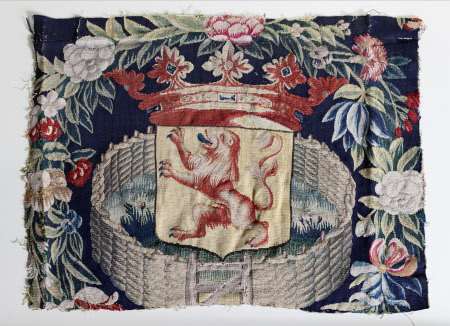Cushion Cover with the Arms of Holland in the ‘Hollandse Tuin’
Northern Netherlands
Category
Tapestries
Date
circa 1680 - circa 1700
Materials
Tapestry, wool and silk.
Measurements
0.40 m (H); 0.52 m (W)
Place of origin
Netherlands
Order this imageCollection
Hardwick Hall, Derbyshire
NT 1129772
Summary
Tapestry, wool and silk, Cushion Cover with the Arms of Holland in the ‘Hollandse Tuin’, Northern Netherlands, c. 1680-1700. A cushion cover with the crowned coat of arms of Holland set within a wattle fence with a gate at the front, and surrounded by a wreath of flowers, all on a dark blue ground. The arms are Or a lion rampant Gules. The tapestry has been cut down and the lower part of the wreath is missing. There is a second almost identical cover at Hardwick, no. 1129771.
Full description
The representation of the Lion of Holland set within a fenced garden came to represent the captivity of the Province of Holland under Spanish rule in the sixteenth century, and the struggle for freedom. The emblem was known as the ‘Hollandse Tuin’ or ‘Garden of Holland’. After the Revolt and the declaration of the Dutch Republic in 1581 the emblem came to symbolise the strength and concord of the entire Republic. A number of cushion covers survive with the Garden of Holland device. They were made for government and civic bodies in the Dutch Republic, and sometimes included the emblems of various administrative councils. A cushion almost identical to the two at Hardwick is in the Rijksmuseum. Hartkamp-Jonxis and Smit date this cover to c. 1680-1700 on stylistic grounds, and suggest that it was made for the States of the Province of Holland, as it includes no additional attributes (Hartkamp-Jonxis and Smit 2004, p. 303). (Helen Wyld 2013)
Credit line
Hardwick Hall, The Devonshire Collection (acquired through the National Land Fund and transferred to The National Trust in 1959)
Makers and roles
Northern Netherlands , workshop
References
Hartkamp-Jonxis and Smit, 2004: Ebeltje Hartkamp-Jonxis and Hille Smit, European Tapestries in the Rijksmuseum, Amsterdam 2004
